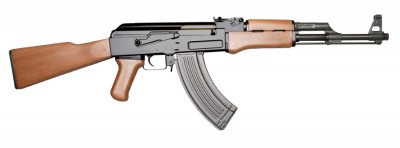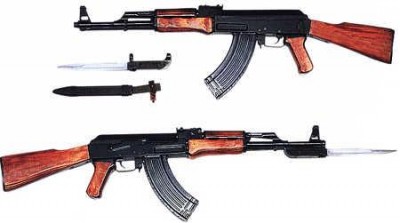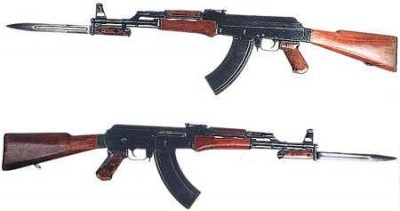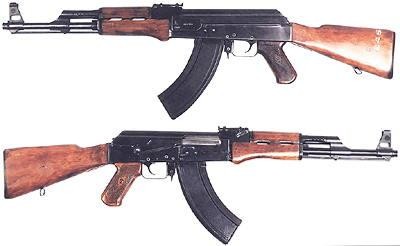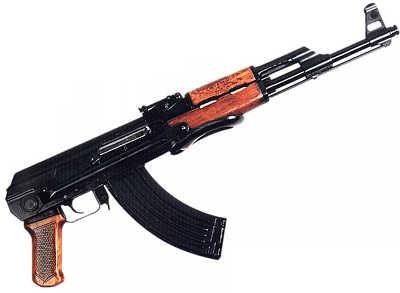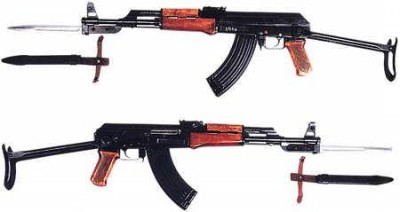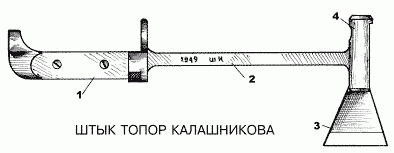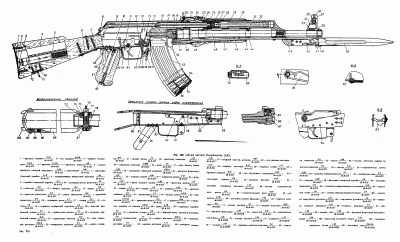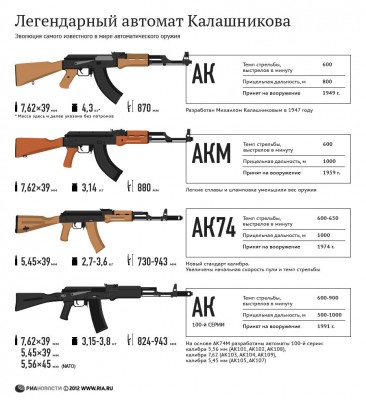| Název: Name: | 7,62 mm útočná puška Kalašnikova | Kalashnikov Assault Rifle, cal. 7,62 mm |
| Originální název: Original Name: | 7,62-мм автомат Калашникова | |
| Kategorie: Category: | útočná puška | assault rifle |
| Výrobce: Producer: | DD.MM.1947-DD.MM.1961 Iževský strojírenský závod, Iževsk | |
| Technické údaje: Technical Data: | ||
| Hmotnost nenabité zbraně: Weight Unloaded: | 4,3 1) kg | 9.48 1) lb |
| Ráže: Calibre: | 7,62 mm | |
| Náboj: Cartridge: | 7,62 x 39 | |
| Délka: Length: | 870 mm | 2 ft 10 ¼ in |
| Délka hlavně: Barrel Length: | 415 mm | 1 ft 4 ⅜ in |
| Kapacita zásobníku: Magazine Capacity: | 30 | |
| Výkony: Performance: | ||
| Rychlost střelby: Rate of Fire: | 600 ran/min | 600 rpm |
| Úsťová rychlost: Muzzle Velocity: | 715 m/s | 2345.8 ft/s |
| Uživatelské státy: User States: | ....... | ....... |
| Poznámka: Note: | všeobecně známý jako AK-47 index GRAU: 56-А-212 1) první výrobní provedení | commonly known as AK-47 GRAU index: 56-А-212 1) first production |
| Zdroje: Sources: | Gordon L. Rottman: Útočná puška AK-47 a její modifikace ru.wikipedia.org | |
7,62 mm útočná puška Kalašnikova (AK)
The Soviet army entered World War II with infantry armament, the composition of which did not differ much from that of armies of other European countries. The basic weapon of the infantry was the repeating rifle (Mosin vz. 1891/30) with a common rifle 7.62x54R cartridge, supplemented in some units by submachine guns (mostly PPD-40) with pistol 7.62x25 cartridge, while officers were armed with pistols (mostly TT-33) using the same cartridge. At that time, Soviet experts, like their colleagues around the world, came to the conclusion that most of the fighting using firearms was at ranges where the conventional rifle cartridge was unnecessarily powerful (and consequently the great weight of the weapon and ammunition), but the performance of the pistol cartridge was often insufficient. On the basis of this finding, under the leadership of N. M. Yelisorov and B. V. Semin, the development of a new rifle cartridge with reduced ballistic performance was initiated. Soviet designers were convinced of the correctness of the development of such a cartridge after the capture of the first examples of the German MP-43 assault rifle (later StG-44), chambered for the new Polte 7.92x33 cartridge. The cartridge was completed in 1943 and introduced into service the same year as the 7.62mm vz.43 (the cartridge is standardized as 7.62x39 by the C.I.P.), but had to wait several years for "its" first weapon.
Already in early 1944, Alexey Sudaev submitted an experimental model of the weapon, chambered for the new cartridge. The weapon was designed with an unlocked, dynamic breech, which, due to the need to handle the power of the cartridge, was considerably heavy, and of course the whole weapon was heavy and bulky. In tests, the individual components of the weapon exhibited poor durability, and the result of the tests showed that Sudaev had "felt the dead end of human knowledge and announced to the world: Not this way, my friends!"
In August 1944, therefore, Sudaev presented a new weapon with a breech lock by swinging the bolt sideways, unlocked by the pressure of burnt gases on the piston. The magazine had a capacity of 30 rounds (the previous model had a magazine capacity of 35 rounds). Tests proved the weapon to be well reliable, and in 1945 a batch of 50 was produced for military trials. After the evaluation of the test results, the weapon was returned for weight reduction. However, this promising project was stopped after the death of Alexei Sudaev in 1946.
As an emergency solution, it was decided to reconstruct the Simonov SKS-41 selfloading rifle of 7.62x54R calibre to the new cartridge. The reconstructed weapon proved to be reliable and accurate, and under the designation SKS-45 it was introduced into service. As the weapon was not designed for batch firing and the design did not offer further development potential, it was clear from the outset that this was only a provisional solution.
History of the weapon:
In 1946, the young (then 27 years old) Mikhail Timofeyevich Kalashnikov submitted a design for his submachine gun, an experimental sample of which, designated AK-1, was produced at the Kovrov Armory in November 1946. In the following comparative tests with the A. A. Dementev of Kovrov and F. Bulkin of Tula, the AK-1 achieved good results, especially reliability, compared to its competitors, and it was recommended to continue the tests. Already during the first round of tests it was decided (according to the recollections of Kalashnikov's colleague Alexander Zaitsev, even against the initial resistance of Mikhail Kalashnikov) to improve the design. The tension lever and safety were moved to the right side, the breech housing is covered from above along its entire length by a trapezoidal (formerly rectangular) cover with a window for ejecting cartridges. The barrel was also shortened, the forend lengthened, the stock mounting changed and the hammer and trigger mechanism improved. Five samples were produced and subjected to another round of testing, which showed that none of the competing models could match the Kalashnikov. In 1948, the Tula Armory produced a test batch for military trials. During these trials, the weapon was found to be easy to use and reliable in all climatic conditions, and in 1949 it was introduced into the Soviet Army's arsenal under the designation "Avtomat Kalashnikova" (Avtomat Калашникова - AK).
The ramp-up of AK production posed a serious technological problem. During the Second World War, the basic criterion for a military firearm in the USSR was simplicity of production, which naturally reflected on the quality and technical perfection. However, the design of AKs, compared to war weapons, placed higher demands on the technological level of production. Although the AK was, compared to Western weapons, more crudely crafted and only the functional surfaces were precisely machined, some technologies, such as the forming of the breech housing from sheet steel or the chrome plating of the bore, presented such a problem at first that mass production of self-loading carbines continued until it was solved SKS. Thus, new AKs did not begin to reach Soviet Army units until late 1949. During the 1950s and 1960s, the AK-47 was included in the armament of all Warsaw Pact countries except Czechoslovakia, as well as in the armament of several dozen countries around the world.
The AKS variant (Avtomat Калашникова со складывающымся прикладом - Avtomat Kalašnikova so skladyvajuščimsja prikladom) with a folding shoulder rest, designed for airborne troops, special purpose units, vehicle crews or technical types of troops, is derived from the basic model. The armrest is made of pressed steel plate and folds down under the forearm. It is otherwise indistinguishable from the basic model.
During the ten years of production, there have been two major design changes. Technological problems with the pressing of the breech housing led to a change to production by milling from forgings in 1951. The second change occurred in 1954 when the rear end of the bolt housing was given a definitive, rectangular, shape and the stock was attached directly to the housing.
The Kalashnikov system is widely distributed throughout the world, where it has achieved such notoriety that it has even become part of the national emblem or flag of some countries (Burkina Faso, Mozambique, Zimbabwe). According to the data in the available literature, by the mid-1990s about 70 million weapons in various modifications had been produced, both in Russia itself and abroad (both licensed and copies - the design was never patented!) The reason for such popularity of Kalashnikov weapons lies in the fact that it managed to combine such solutions that provide a compact and robust weapon with high utility characteristics, with high operational reliability and relatively low production costs. Moreover, the design has enabled the unification of a whole range of small arms - the rifle (automatic) and the handgun are of the same design, differing only in barrel length and accessories.
Construction:
The AK is a fully automatic weapon with a locked breech and automatic propulsion by taking burnt gases from the barrel and pressing them against the piston. The breech is locked by means of a pivoting bolt whose teeth fit into recesses milled into the breech housing. The percussion gear is cocked with an automatic trigger. The bolt housing is milled from a steel forging (pressed from steel sheet until 1951) and is covered from above by a smooth-walled lid pressed from steel sheet.
The bore of the hot-forged barrel is hard chrome plated. The barrel is pressed into the breech housing. A gas extension is moulded roughly in the middle of the barrel length, and a fly carrier is moulded just behind the muzzle, with a bayonet catch at the bottom. The first series lacked the bayonet lug under the fly carrier.
The stock and forend are made of wood. The stock is bolted to a grip attached to the rear end of the bolt carrier, but from 1954 it was bolted directly to the carrier. There is a hole cover in the stock boot for storing cleaning supplies (the wiper is stored under the barrel). The stock was made of laminated wood or, later, plastic.
The sights are open. The flap sight is adjustable in height with calibration up to 800 m. The sight is adjustable in height and sideways. The sights are fitted with tritium dots under the notch on the sight and on the reticle.
The magazine is a detachable segmented magazine with a capacity of 30 rounds. The side walls of the magazine are flat, without mouldings (a newer magazine from AKM with longitudinal reinforcing mouldings can also be used in the gun).
The AK submachine gun includes a knife bayonet with a 210 mm blade. At the interface between the blade and the handle, a crossbar with a thimble was riveted or soldered to the muzzle of the barrel. The rear end of the handle, curved upwards, had a semicircular cut-out at the top, which rested on the barrel from below. The lock securing the bayonet to the weapon was located just behind the crossbar (the bayonet catch was located on the weapon under the fly carrier). The blade of the blade could be at the top or at the bottom. The grip shanks were made of reddish-brown plastic, or plastic filled with wood fibers.
Technical data:
Type - AK (AKS)
Calibre - 7.62 mm
Cartridge - 7.62 mm vz.43 (7.62x39)
Overall length - 870 mm (880/645 mm)
Barrel length - 415 mm
Empty weight - 4.3 kg (3.8 lbs)
Weight of loaded weapon - 4.876 kg (4.376 lb)
Cadence - 775 rounds/min
muzzle velocity - 715 m/s
Number of grooves - 4
Groove pitch - 235 mm to the right
Length of intentional - 378 mm
Magazine capacity - 30 rounds
Note: Technical data differs from one source to another, notwithstanding the differences between the different variants of the weapon. The data given here are valid for the model produced in 1954-1959. In case the data in the literature differed, I have tended to either the prevailing data or the contemporary Russian data.
Production:
The AK submachine gun was produced in the USSR from 1949 to 1959 by Izhevsk and Tula.
It was produced abroad under license in the following countries:
AK:
- Bulgaria - AKK (Avtomaticheskij karabin Kalashnikova)
- China - Type 56
- Yugoslavia - Automatska rifle vz. 64
- DPRK - Type 58
- Hungary - AK-55
- NDR - Mpi-K (Maschinenpistole Kalaschnikow)
- Poland - PMK (Pistolet Maszynowy Kalasznikow) or Kbk-AK (Karabinek Automatyczny Kalasznikow)
- Romania - AI
AKS:
- China - Type 56-1
- NDR - Mpi-KS (Maschinenpistole Kalaschnikow mit geklappbarem Schulterstütze)
- Poland - PMK-S
Markings:
Soviet-made AKs were marked on the left side of the breech housing with the year of manufacture and serial number, which was repeated on the rear and cover of the breech housing and on the right side of the forend.
The positions of the safety on Soviet-made weapons were marked with dots and indicated by means of an electric needle with the letters AB (sometimes also ABT - by doses) and OД (by individual shots).
The topic of marking of weapons from licensed production is so voluminous that it would be worth a separate article, so I have concentrated (not only in this paragraph) only on Soviet-made weapons.
This post has not been translated to English yet. Please use the TRANSLATE button above to see machine translation of this post.
Automat AK-47 s frézovaným pouzdrem závěru, vyrobený v letech 1951-1954. Povšimněte si kovové příchytky pažby.
This post has not been translated to English yet. Please use the TRANSLATE button above to see machine translation of this post.
Source :
The 7.62 mm Avtomat Kalashnikov (AK),
Rukovodstvo po srednemu remontu, Moscow, Vojenizdat 1970.
AK, AKM and AK-47[/heading]
Translation of descriptions (top to bottom):
AK:
The rate of fire, shots per minute: 600
Sighting distance: m: 800
Accepted into service: 1949
the Weight is listed without a sponsor.
Was developed by Mikhail Kalashnikov in 1947.
AKM:
The rate of fire, shots per minute: 600
Sighting distance: m: 1000
Accepted into service: 1959
Used light alloy and molding have reduced the weight of the gun.
AK-74:
The rate of fire, shots per minute: 600-650
Sighting distance: m: 1000
Accepted into armaments: 1974
a New standard caliber.
Increased the initial velocity of the bullet and the temp of the shooting.
AK (th series):
The rate of fire, shots per minute: 600-900
Sighting distance: m: 500-100
Admitted to the loadout: 1991
On the basis of the AK-74M have been developed machines 100 series:
- caliber 5.56 mm (AK-101, AK-102, AK-108)
- caliber 7.62 mm (AK-103, AK-104, AK-109)
- the caliber of 5.45 mm (AK-105, AK-107)
Source: nnm.me
..
Diskuse
This post has not been translated to English yet. Please use the TRANSLATE button above to see machine translation of this post.
This post has not been translated to English yet. Please use the TRANSLATE button above to see machine translation of this post.
K údajom uvedeným v TTD - Tango to už ozrejmil:
Citace :
Pozn.: Technické údaje se v jednotlivých pramenech odlišují, nehledě na odlišnosti jednotlivých variant zbraně. Zde uvedeny údaje jsou platné pro model vyráběný v letech 1954-1959. V případě, že se údaje v literatuře rozcházely, přiklonil jsem se buď k údajům převažujícím nebo k současným ruským údajům.
This post has not been translated to English yet. Please use the TRANSLATE button above to see machine translation of this post.
This post has not been translated to English yet. Please use the TRANSLATE button above to see machine translation of this post.
Citace - Anorektik :
v jednej knihe som čítal že kadencia je 600 výstrelov za minútu je to pravda? alebo je to tak ako to napísal tango?
Podle ucha je u AK-47 kadence vyšší, čili 650 bych viděl (slyšel
Join us
We believe that there are people with different interests and experiences who could contribute their knowledge and ideas. If you love military history and have experience in historical research, writing articles, editing text, moderating, creating images, graphics or videos, or simply have a desire to contribute to our unique system, you can join us and help us create content that will be interesting and beneficial to other readers.
Find out more